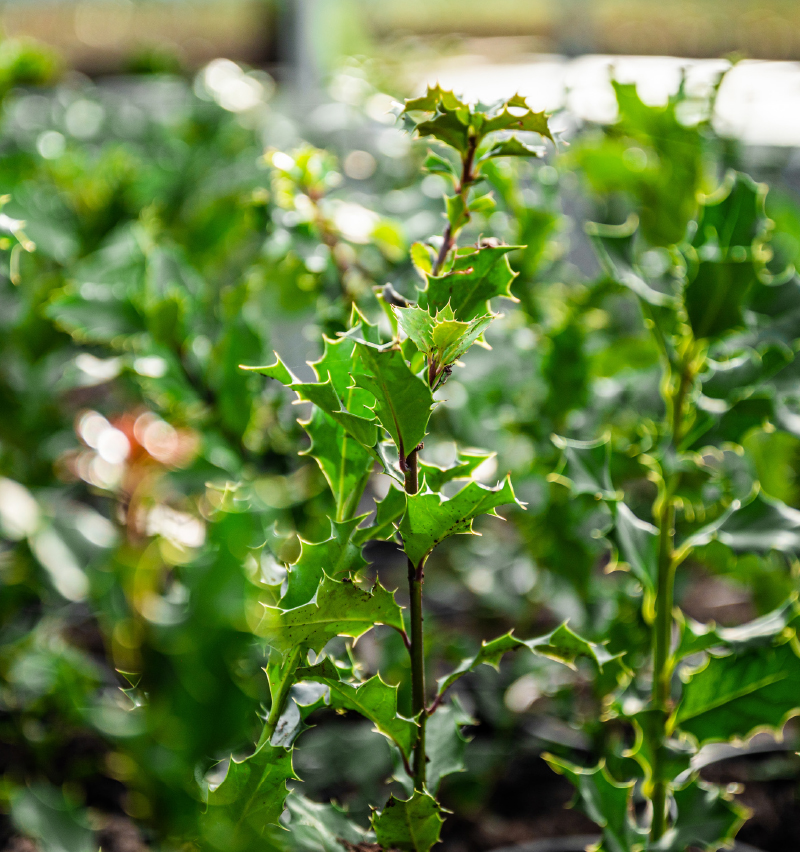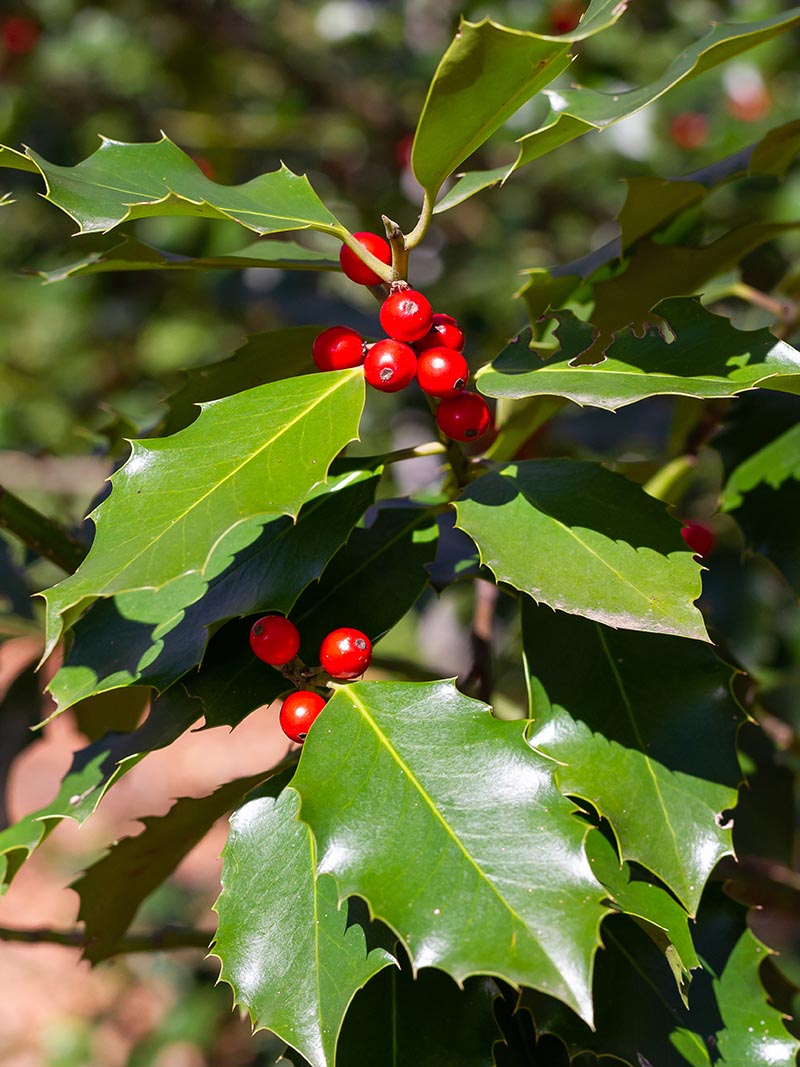Focus on: Ilex
A festive favourite for all seasons
Ever-popular in winter but beautiful all year round, Ilex is a plant genus that’s collectively made up of around 480 evergreen and deciduous shrubs and trees. Ilex is more commonly known as holly and is part of the Aquifoliaceae family of plants. In fact, it’s the only genus within this family. Native to tropical, subtropical and temperate regions, Ilex can be found in many parts of the world, but thankfully, most species are fully hardy in the UK.
Did you know?
The mistle thrush is extremely territorial and will guard the berries of holly during the winter. This is known as resource guarding, and they will often guard in pairs.
Ilex is a very versatile and valuable ornamental plant for landscapes, and there are many different species to choose from, ranging from small trees to shrubs of various sizes. Classic holly varieties have standout, lustrous, green foliage with serrated or spiny edges; these can be cut to make lovely festive decorations. Whereas other species have smaller, softer foliage—ideal for topiary. The majority of Ilex species have dark green leaves, but some varieties can have a purple hue or be variegated in colour. A great benefit of Ilex is its ability to provide colour throughout the year with its multiple seasons of interest.
Most Ilex species are dioecious—meaning individual plants produce either female or male reproductive structures. In order to produce berries on female plants, a male plant will need to be in close proximity, allowing insects to cross-pollinate between their nectar-rich flowers. Berries will usually emerge in autumn on female plants and colours vary between red, black, white and yellow.
Ilex provides fantastic benefits for wildlife; its nectar and pollen-rich flowers are great for attracting bees; its berries provide birds with an excellent late food source; its dense cover provides birds with shelter, habitat and nesting opportunities; and small mammals appreciate the leaf litter for their hibernation period.
Our favourite Ilex varieties
Ilex aquifolium
Commonly known as English holly or common holly, Ilex aquifolium is a slow-growing, evergreen species that usually has spiny, green foliage. Growing taller than 12m with a bushy habit, Ilex aquifolium is excellent when grown as a specimen tree, clipped bush or hedging. White flowers usually emerge in late spring or summer, and pollinated, female plants put on a show in autumn and winter with striking red berries. This is a particularly popular holly species for festive floral arrangements. Two of our favourite Ilex aquifolium varieties are ‘Argentea Marginata’ and ‘Silver Queen’.
Ilex aquifolium ‘Argentea Marginata’ is a variegated, female holly with spiny foliage. New shoots grow with a slight tinge of pink and later mature to a dark green with striking, silver margins. This female holly produces bright red berries in autumn and winter, which provide birds with an excellent food source during the latter part of the year.
Famous for its dramatic foliage, Ilex aquifolium ‘Silver Queen’ has a dense, upright habit. New shoots emerge purple in colour and its young, spiny leaves have a slight pink hue, until they mature and turn green with distinctive, silver margins. ‘Silver Queen’ is a male holly; this means it does not produce berries, but its white flowers in spring are great for pollinating female holly varieties, when positioned in a nearby spot.

Ilex aquifolium ‘Argentea Marginata’

Ilex creanata ‘Caroline Upright’
Ilex crenata
Native to Japan, China and Korea, Ilex crenata—known as Japanese holly—is an evergreen holly species with a more compact, dense habit. Ilex crenata is ideal for topiary as its small, green, glossy leaves offer a similar look to Buxus sempervirens (common box) and its slow growth rate helps it to stay in shape, with little effort. In addition, Ilex crenata is resistant to box blight and isn’t prone to leaf scorch after pruning. Due to its slow-growth rate, Ilex crenata is also a great option for low hedging along a border or path. A few of our favourite varieties are ‘Green Hedge’, ‘Stokes’ and ‘Carolina Upright’.
Ilex crenata ‘Green Hedge’ is a compact shrub that grows up to around 1.5m in height. Usually grown for its dense, oval-shaped, green foliage, ‘Green Hedge’ is great for compact hedging and larger topiary shapes. ‘Green Hedge’ has small, white flowers which emerge in summer, followed by insignificant black berries in autumn.
A mound-forming and compact variety, Ilex crenata ‘Stokes’ is a fantastic male holly for topiary globes, ground cover or low hedging. ‘Stokes’ grows up to 1m in height and has dark green, small, oval-shaped foliage. Its delicate, white flowers emerge in May and attract plenty of bees and butterflies.
Another male variety, Ilex crenata ‘Carolina Upright’ is compact and dense, with an upright habit—great when grown as a specimen shrub in containers or flower beds and borders. ‘Carolina Upright’ grows up to 2.5m in height, and has small, ovate, dark green leaves, with delicate, white flowers in spring and summer.
How to grow and care for Ilex
Early spring and autumn are ideal seasons to plant Ilex, but it can do well when planted at any point in the year. Ilex can be planted in most light levels, from partial shade to full sun. However, keep in mind that female plants will produce more berries when positioned in full sun. An advantage of Ilex is its tolerance of pollution and salt-laden air—making it ideal for coastal and urban locations. Ilex will thrive in most moist, well-drained soils.
Being low maintenance, Ilex doesn’t require much effort to help it thrive. Whilst it’s establishing, regular watering is essential to keep the soil moist. Plant feed generally isn’t required for Ilex; however, you can feed it once a year in spring, followed by a biodegradable mulch. If your Ilex is container grown, it should be fed twice a year with a slow-release plant feed.
Ilex responds well to pruning—we recommend once per year in late winter or early spring. Encourage new growth by removing any misplaced, damaged or diseased branches. If further shaping is required later in the year, ensure this is carried out no later than July, to avoid frost damage to any new shoots. Ilex crenata in particular tolerates heavy pruning—great for keeping topiary styles neat and tidy throughout the year.
Ilex can suffer with various pests and diseases, such as aphids, scale insects, holly leaf miner and holly leaf blight. Holly leaf miner causes yellow-white or yellow-purple blotches on mature foliage; however, it has very little impact on the health of the plant. Holly leaf blight is a fungal disease that causes black or purple blotches on leaves and dieback of stems. It usually occurs in the colder months and after particularly cool, wet weather. If you spot any signs of holly leaf blight, remove infected parts of the plant and any dead stems.
If you’d like to find out more about the Ilex varieties which we grow and supply, get in touch with the G Team today.




